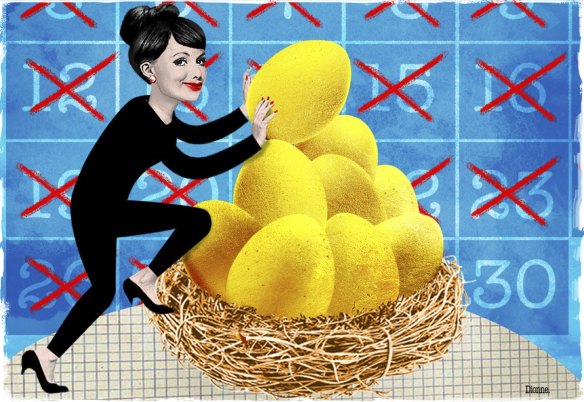This was published 3 years ago
Opinion
The tax trick everyone earning more than $45,000 needs to know
Jessica Irvine
Senior economics writerWho knew Australians were so passionate about their superannuation?
Without getting into the specifics of the housing versus super debate again, I am excited young Aussies seem to have woken up to the fact that super is both REAL money and YOUR money.

Credit: Dionne Gain
The worst thing about super is that you can’t touch it until you’re at least 60 (which is actually the whole point – the government knows you’re really bad at saving money and wants to help “future you” live a more comfortable retirement).
The best thing about super is the HUGE tax concessions that are available on money saved this way – particularly for higher-income earners.
As the end of the financial year approaches, it’s time for everyone, particularly those earning more than $45,000 a year, to have a good look at the tax savings available on money funnelled into super.
Why do I say more than $45,000?
Well, because that’s the income threshold above which you start paying 34.5¢ tax in the dollar (including the Medicare levy of 2¢ in the dollar). Not on every dollar, mind you, just the dollars you earn exceeding $45,000.
Because dollars you plough into super are taxed at a low flat rate of 15¢ (up to an annual limit of $27,500), there’s an immediate tax savings there of 19.5¢ in the dollar.
For income earned over $120,000 and put into super, the per dollar tax saving rises to 24¢, and to 32¢ for income earned above $180,000.
It’s a totally legitimate tax rort, indeed, one designed specifically to incentivise extra contributions to super.
Should you do it? Well, that’s up to you.
Personally, I think, in general, most younger Australians need to prioritise saving for a home deposit before electing to squirrel too much into super. Everyone has 10 per cent of their wage going into super already, of course, and attracting the same tax discount.
However, if you do have some extra cashflow month-to-month, or a lump sum of savings you don’t wish to access until after 60, topping up your super can be a great financial strategy to consider.
There are two ways to make voluntary contributions to your super.
One way is to make a tax-deductible lump-sum transfer into your super fund from your post-tax savings before the end of the financial year.
I did that last year, and it generated a significant tax refund for me.
There is a strict paperwork process to follow if you wish to claim a voluntary contribution to super as a tax deduction at tax time.
You must fill out an approved “notification of intent to claim” form, send it to your super fund and have it acknowledged before you submit your tax return.
You must also make sure your super fund has received your contribution before the end of the financial year in which you intend to claim. That is, make sure you transfer the funds with enough time for them to clear your bank account and land in theirs before the clock strikes midnight on June 30.
If you’re interested in this strategy, it’s worth a phone call to check with your super fund how much room you have left to contribute up to the annual $27,500 concessional contributions cap. Importantly, this cap includes both voluntary savings and the compulsory super contributions your employer makes on your behalf.
But wait! There’s more! Due to relatively recent legislative changes, it is now possible to access previous years’ unused concessional super caps stretching back to 2018-19.
Log in to your MyGov account and look at the superannuation section of the Tax Office portal called “carry forward concessional contributions,” to see how much you may be able to use.
Of course, you have to be happy to part with your money until at least 60. But you get to decide how you spend (or save) any resulting tax refund today.
This financial year, I took the second approach available to make extra contributions up to the $27,500 annual concessional cap. I elected to salary sacrifice a portion of my paycheque each fortnight straight into my super fund throughout the year.
To calculate how much, I started with the $27,500 cap, deducted my employer’s likely annual compulsory contributions and then split the rest over the 26 fortnights over which I am paid.
If my calculations are correct (and I have erred on the lower side to be sure) I should come in just under the cap this year.
The advantage of making regular contributions is that the money I would otherwise have paid in higher income tax has instead been hitting my super account at regular intervals, rather than sitting with the Tax Office to be claimed back later.
Both strategies are worth considering. Tell your friends and family.
Advice given in this article is general in nature and is not intended to influence readers’ decisions about investing or financial products. They should always seek their own professional advice that takes into account their own personal circumstances before making any financial decisions.
Jessica Irvine is author of the bestselling new book Money with Jess: Your Ultimate Guide to Household Budgeting. You can follow more of Jess’ money adventures on Instagram @moneywithjess and sign up to receive her weekly email newsletter.